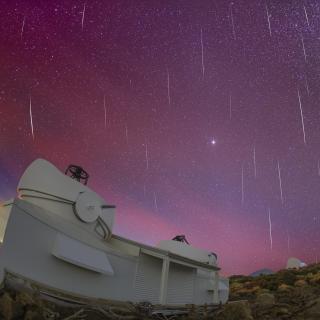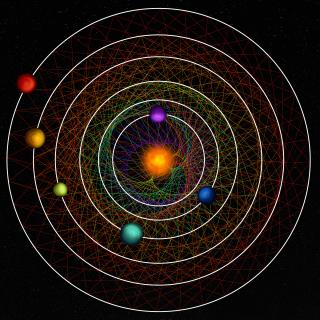The results of this study were published on Saturday, 10 March, in the specialist publication Astrophysical Journal Letters
AVAILABLE IN 3D ANIMATED BETACAM MOVIES, INTERVIEW WITH ONE OF THE RESEARCHERS (Tel.: 34 922 605206 and 34 922 605 371)
David Martínez, Antonio Aparicio y Ricardo Carrera, from the Stellar Populations in Galaxies group of the Instituto de Astrofísica de Canarias (IAC) and María Ángeles Gómez Flechoso of the University of Geneva have discovered what is considered to be the most solid observational proof so far of the destruction of a dwarf galaxy in the nearby vicinity of our Milky Way Galaxy.
The theory on the formation of galaxies currently having the widest acceptance implies that dwarf galaxies were the first to form in the Universe. Many of these then either went on to clump together to form larger galaxies or were gradually swallowed up by larger galaxies that continued to grow in this way. This process means the destruction of dwarf galaxies, such as is observed directly or indirectly in distant systems.
It was suspected that our own Milky Way Galaxy also took part in this mechanism; in other words, that, being large galaxy, it had acquired a goodly portion of its mass by "devouring" smaller galaxies. In 1994, a new dwarf galaxy, Sagittarius, was discovered very close to the Milky Way and located on the diametrically opposite side of the Galactic Centre from the Sun. This satellite orbiting the Milky Way is the closest known galaxy to us and is at present situated within the outermost diffuse limits of the Milky Way at a mere 15 kiloparsecs (kpc) from the Galactic Centre (1 kpc is equal to 3262 light years).
From the first, it was thought that the Sagittarius galaxy had reached an advanced state of destruction, and that a large part of its original matter now formed part of the Milky Way. It now seemed possible to view directly the destruction of a dwarf galaxy (Sagittarius) as it was engulfed by a large galaxy (the Milky Way); in other words, an opportunity had arisen to study in detail and at first hand the mechanism governing the formation of large galaxies. If this were the case, it should then be possible to find stars that originally formed part of the dwarf galaxy, and that would now be strewn along its entire orbit, thereby constituting two streams encircling the Milky Way. The problem was that these streams would extremely diffuse; so much so that they might turn out to be completely indistinguishable, even at short distances from the centre of Sagittarius itself.
The "debris" of Sagittarius
In 1998, investigators from the University of Michigan found the apparent remains of one of the streams, that extending to the south west, and could trace it out to 34o from the centre of Sagittarius. Theoretical models predict the presence of another symmetric stream, extending to the north west, that could be so long as to encircle our Galaxy completely. However, this stream would be even more difficult to identify since it would cross the disc of the Milky Way and be hidden by the Galactic Centre.
Using the 2.5 m Isaac Newton Telescope at Roque de los Muchachos Observatory on La Palma and relying on evidence supplied by their own dynamical models of Sagittarius and on preliminary results from the sky survey now being carried out by the international Sloan Digital Sky Survey team, researchers from the IAC have been the first to identify an excess of young stars belonging to a stellar system located at 56 kpc from the centre of the Milky Way. Its position in the sky indicates that we are probably dealing with debris belonging to the northwest current of Sagittarius 60o (equivalent to 65 kpc measured along the orbit of Sagittarius) from the centre of the dwarf galaxy. These remants are the furthest from the centre of a progenitor galaxy ever detected and confirm that the Sagittarius galaxy has formed an arc that completely surrounds our Galaxy, just as predicted by theoretical models.
This discovery, to be published next Saturday (10 March) in Astrophysical Journal Letters, gives practically incontrovertible direct observational proof not only that Sagittarius is in an advanced stage of destruction but also - more importantly ' that the process we may term "cannibalism" has played and continues to play an important role in the formation of the Milky Way. IAC astronomers continue to search the sky for new debris from Sagittarius in order to improve the dynamical models of destruction and our understanding of the role that these kinds of processes play in the formation of the Milky Way.
(1) The Isaac Newton Telescope (INT) belongs to the Isaac Newton Group of Telescopes (ING) of the Particle Physics and Astronomy Research Council (PPARC) of the United Kingdom.
3D Animation avi 1116Kb


